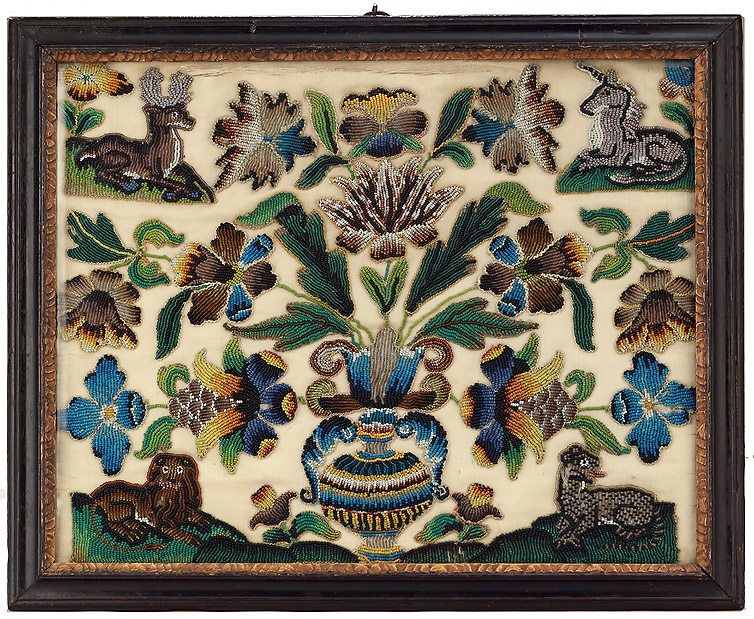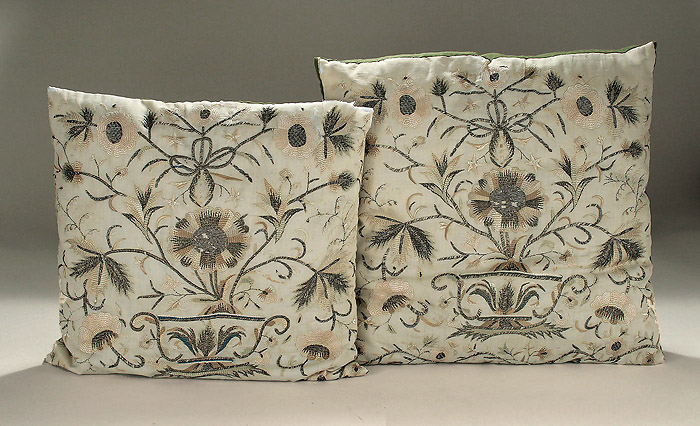|
In Honor of Mother's Day
'NEEDLEWORK'
A Maternal Tradition

Needlework is one of the oldest art forms.
Ancient Chinese examples of needlework dating to 30,000 BC exist -
some with ivory beads.
In the Western world, needlework and embroidery date back about 3000 years.
And its tradition seems entwined with a feminine transference throughout the generations.
In the Roman culture, the goddess Minerva served as the patroness of females,
to whom she conferred skills in needlework,
including sewing, spinning, and weaving.
These skills were not only for domestic need, but for artistic enhancement.
About 1,000 AD, needlework and embroidery took hold throughout Europe.
Nobility and high clergymen began to commission embroidered garments,
wall hangings, and tablecloths as a demonstration wealth and status.
|
1100 -1350 marked the greatest period
in English embroidery,
known throughout Europe as
"opus anglicanum"
(English embroidery),
often using gold and silver threads
on rich
velvet or linen grounds.
Most was for liturgical use.
c1330-50 British Chasuble
(Opus Anglicanum)
51 x 30 in.
|

|
During these Middle Ages, the professional needlework and embroideries
were actually executed more by men than women.
Unfortunately, as the embroidery industry grew and became more commercialized,
the historical records grew "conspicuously silent about women's contributions".
However, times were to change - and in the 16th century,
embroidery became a symbol of power, virtue, and entitlement
among women who had the time to do it.
Fine needlework became a marker of economic class -
even Royalty :
|

|
"Embroidered book cover
made by Elizabeth I
at the age of 11", 1544,
presented to Katherine Parr"
|
About 1600, commercial looms became available in England and Europe,
releasing the skills of these ladies to take needlework to a new dimension.
And in time, needlework, usually taught by her mother and grandmother,
even became the young lady's "rite of passage" into adulthood,
even into 18th and 19th century America.
My maternal grandmother was born into that era, in 19th century southern America.
She was the youngest of 6 daughters, each instructed in fine needlework and lace-making
by my great grandmother and her sisters.
She too carried on the tradition, further instructing her female heirs until her death in her 90s.

Above : Two embroidery and lace batiste dresses by my maternal grandmother,
left, with handmade lace and worn by my mother, and later by me;
and right, with underslip and embroidery, made for my daughter
THUS IN HONOR OF 'MOTHER'S DAY',
WE OFFER THIS SMALL SELECTION OF 'FINE NEEDLEWORK'
BY WOMEN OF THE WESTERN WORLD
Beadwork - possibly the earliest form of embroidery -
can be traced to the bone and shell adornments of early humans.
Examples have been found in archaeological sites on virtually all continents.
Beaded clothing remains from ancient Egypt.
Beads were used to decorate items used for religious ceremonies
in ancient Greece, Turkey and the Rome

Fragment of Glass Beads, Oldbury Type, Late Iron Age or Roman, 300BC to 400AD
West Yorkshire Archaeology Advisory Service
By 1291, glassmakers in Italy had begun production of intricate glass beads -
the first as tiny rosary beads.
About 1470, the glassmakers of Venice, then in Murano,
began to make glass canes, cut and refined by grinding or heating
into tiny beads for decoration of clothing for the wealthy -
exporting
them throughout the Mediterranean, parts of Europe and even to the New World.
By the 17th century, these glass beads
(which incidentally do not lose their color)
became very popular in England for the decoration of purses, jewelry boxes, baskets
and small pictures - as the glass beadwork floral picture below :

CHARLES II GLASS BEADWORK ON SILK EMBROIDERY
England, c1670-1680
The lower center with a handled vase issuing elaborate flowers and foliage,
accompanied in the four corners by a stag and a unicorn above, and a lion and a leopard below,
each on a grassy mound, all on a cream silk ground,
and housed in an antique frame with carved gilt liner
12" x 15.5" Sight Size / 14.25" x 17.75" Framed Size
In Portugal, an area named Castelo Branco had a unique climate,
capable of growing its own mulberry trees and producing silk.
Trade for many years with India, plus extensive trade with England
resulted in exquisite and elaborate Jacobean type designs in native silk
on coverlets called "colcha",
embroidered by the Castelo Branco village ladies
from the 1600s through the 1800s.

FINE CASTELO BRANCO SILK EMBROIDERY
'COLCHA' (MARRIAGE COVERLET)
Portugal, 18th Century
Embroidered originally as a marriage bedspread,
the silk strands changing color as they reflect the light :
this rectangular linen ground is embroidered with thousands of long flat slightly twisted cream
silk filaments ('slack stitches'), and perpendicularly 'couched' with
single threads for security,
the decoration in the Asian-influenced Jacobean manner, and outlined in gold 'chain-stitch',
each object having a specific marital meaning :
centering a vase, possibly an 'albadarra', an Arabic term for a vase with two handles,
with two birds representing the newlyweds, above two fish;
sided by two pairs of larger birds and within a field of various flora,
each with a meaning;
as well as a pair of large cockerels at the top and bottom, each representing the Blessed Offspring,

all within an inner woven border of conjoined further rosettes and flora;
trimmed in gold floral-woven edging; the green silk backing later, with loops for hanging
78" High, 49.6" Wide
Amazing condition!
It is said that it took 6 women working for 6 months to produce one such 'colcha'.
In addition to beaded embroidery, 17th century England produced
a raised, stuffed needlework called "stumpwork".
Toward the end of the 17th century, the raised work began to flatten out,
resulting in the often delicate openwork of these 18th century embroideries,
still using silk as well as various metallic threads :

PAIR OF SILK & SILVER THREAD CREWEL EMBROIDERY PILLOWS
The Silk and Embroidery 18th Century
The pair of silk pillows,
each depicting a stylized urn resting on a leaf and issuing flora,
each stitched with a combination of silk and silver thread embroidery,
moss green cotton backing
13" x 13", and 15" x 15"
The availability of machine needlework and embroidery has eroded this tradition considerably.
However I am told there is now a resurgence of the love and execution of fine needlework in the 21st century.
I hope it will soon be 're-enjoyed' by many who wish to follow
the tradition of generations of "mothers" and "grandmothers" who preceded them.
Footnotes : 'Creative Commons Images', in Order of Appearance
"Ladies in a Garden Embroidering"
between 1603 and 1637: Ladies seated at their embroidery,
including one engaged in lace-making, and another at the virginal, with a man beside her singing.
Behind, a formal garden, with clipped hedges, parterres, and fountain,
Image from "Album Amicorum of Gervasius Fabricius".
Originally published/produced in Würzburg and Salzburg; 1603-1637;
British Library / Creative Commons.
British Chasuble (Opus Anglicanum), c1330-50
Silver and silver-gilt thread and colored silks in underside couching, split stitch, laid-and-
couched work, and raised work, with pearls on velvet / 51 x 30 in.
Metropolitan Museum of Art / Fletcher Fund, 1927 / Creative Commons
"Embroidered book cover made by Elizabeth I at the age of 11, presented to Katherine Parr"
Elizabeth I of England - English Embroidered "Bookbindings", Cyril James Humphries
Davenport, F. S. A,. London, 1899, dedicated:
'From Assherige, the last daye of the yeare of our
Lord God 1544 ... To our most noble and vertuous
Quene Katherin, Elizabeth her humble daughter wisheth perpetuall felicitie and everlasting joye.'
Creative Commons
Fragment of Glass Beads, Oldbury Type, Late Iron Age or Roman., 300BC to 400AD
West Yorkshire Archaeology Advisory Service, Jack Coulthard / Creative Commons
ONE MORE ASIDE REGARDING WOMEN, THEIR DAUGHTERS & NEEDLEWORK
I cannot complete this 'maternal tribute' without including
the weavers of tribal rugs from the Near and Middle East.

Their works are also very much a 'lady thing'.
Village women of the East have long been responsible for textile production,
a skill requiring distinctive female patience, precision and attention to small details.
These skills have been passed down through generations of females,
preserving unique traditional symbols and regional cultures,
as well as adding to household incomes.
Please remember this when viewing early tribal rugs.
Below are links to two exceptional antique 'lady-made' flatweave rugs,
in which the individual stitches appear more akin to 'needlework'
than the 'piled' rugs :
Rare Caucasian Verneh Dragon Sileh Carpet Caucasus, c1880
Rare Antique Finely Woven Bidjar Soumak (Flatweave) Tribal Rug Persia c1900
Inventory Photography : Millicent F. Creech
|